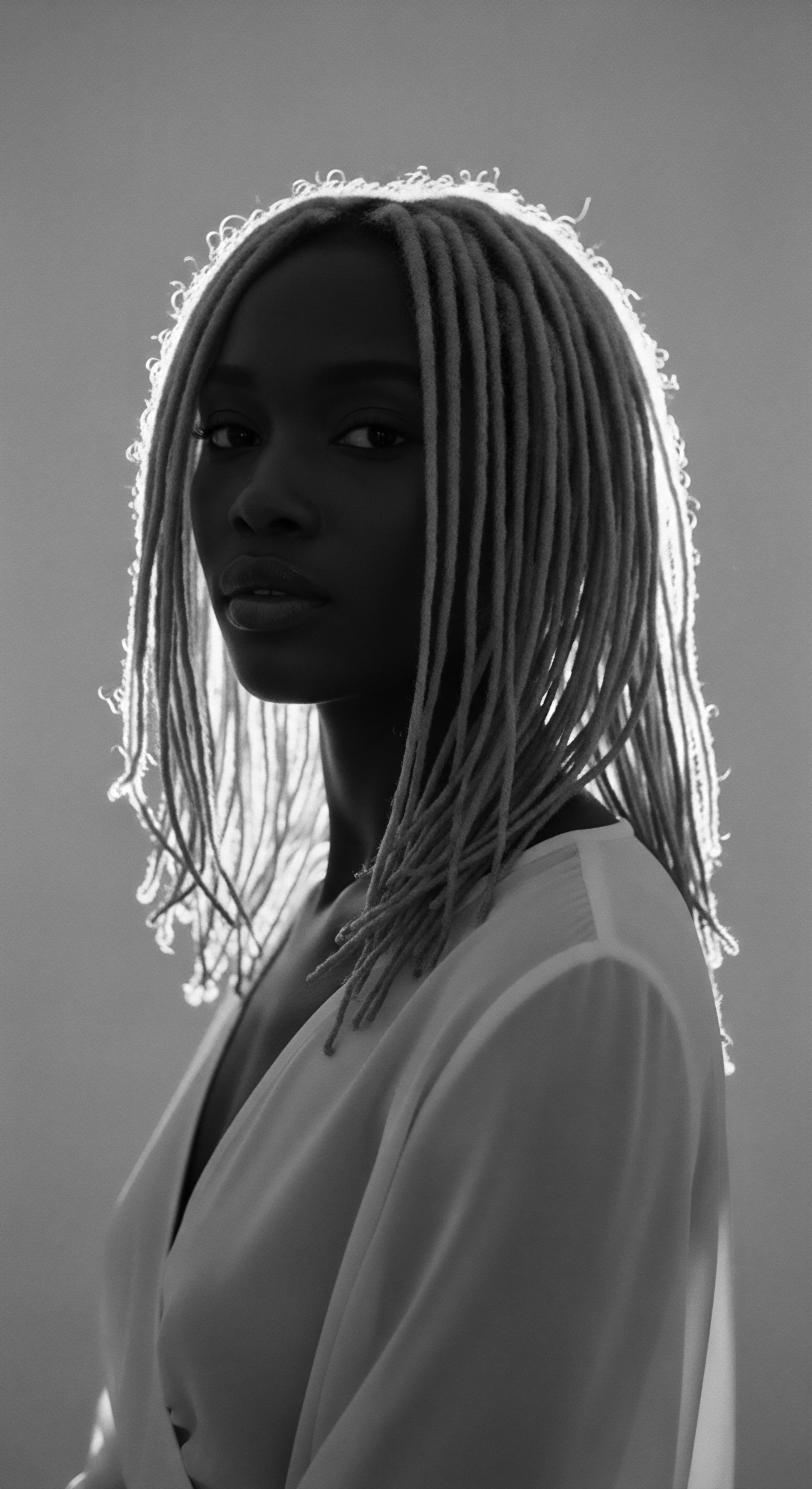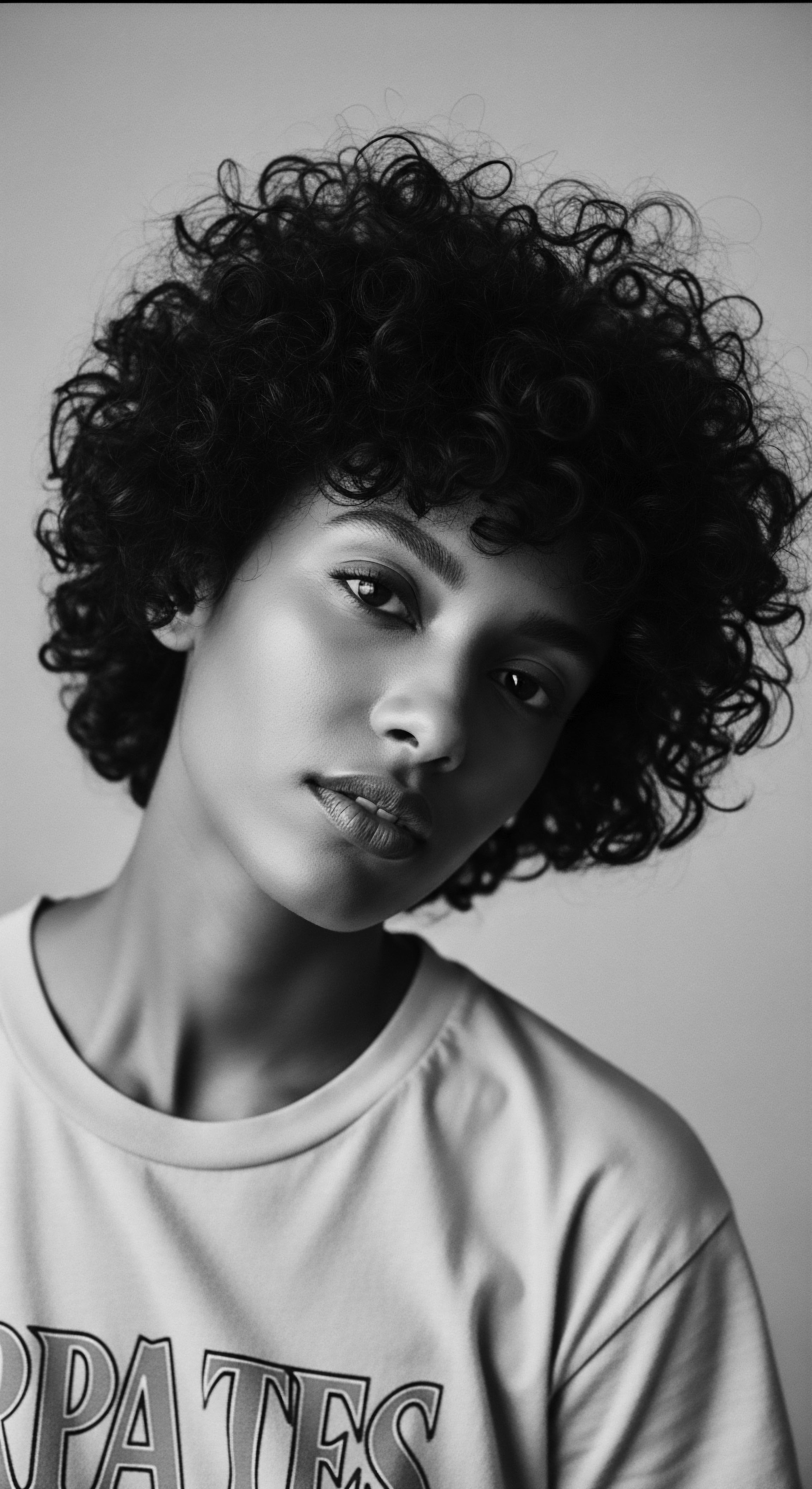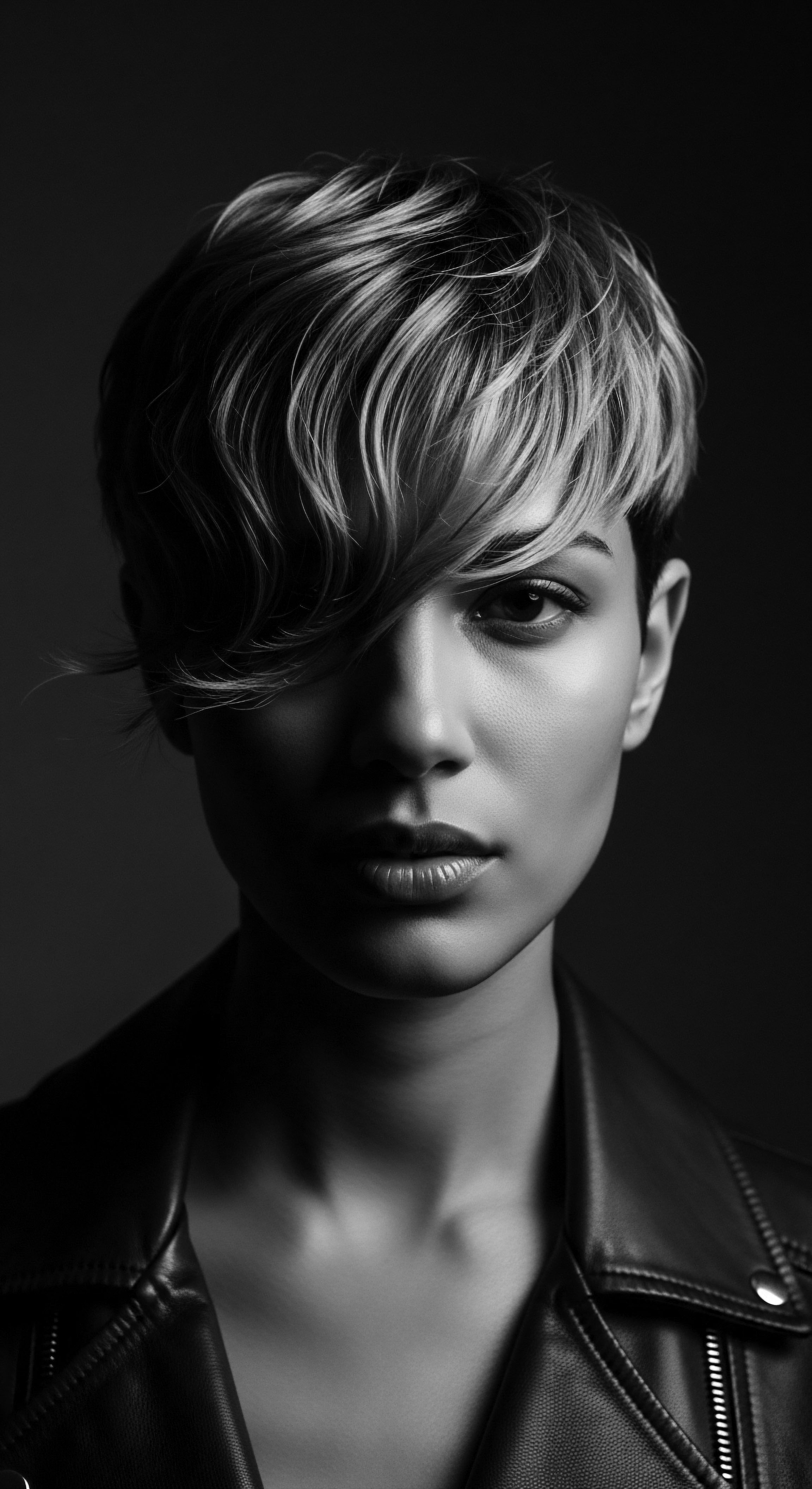
Fundamentals
The conceptual fabric of Burkina Faso, when understood through the lens of textured hair heritage, embodies a vibrant, living archive of ancestral wisdom and enduring practices. It is not merely a geographical designation; rather, it stands as a symbol, an expression, and a deep wellspring of knowledge regarding the holistic care and cultural significance of hair within Black and mixed-race communities. This fundamental understanding acknowledges that the land once known as Upper Volta, now Burkina Faso, holds within its very soil and the hands of its people an unbroken lineage of hair traditions that predate colonial impositions, stretching back into antiquity. These traditions speak volumes about identity, community, and an intimate relationship with the natural world.
At its very simplest, this concept of “the Burkina Faso” articulates a profound connection between the earth, its botanical offerings, and the well-being of the crown. It highlights the elemental biological truth of textured hair, recognizing its unique structure and inherent needs, which ancestral inhabitants understood with remarkable clarity. Before the advent of modern scientific tools, observation and generational experience guided the development of sophisticated hair care rituals.
These practices were rooted in the availability of local flora, the rhythm of seasons, and a communal spirit that saw hair not as a solitary adornment, but as a public declaration of one’s place within the societal tapestry. The initial meaning, therefore, is one of an indigenous, self-sustaining beauty ethos, where the landscape itself dictated the terms of care, and human ingenuity responded in kind.
This notion provides a foundational explanation for the reverence surrounding hair in West African cultures. It serves as a reminder that the care of hair was, and continues to be, interwoven with life’s significant moments, from birth to initiation, marriage, and beyond. The communal act of braiding, for instance, transcends mere styling; it becomes a dialogue, a transfer of knowledge, and a strengthening of familial bonds.
The warmth of human hands working through strands, the shared stories, and the quiet moments of connection—these are all integral to the initial interpretation of this Burkina Faso-inspired hair heritage. It is a heritage of nurturing, of belonging, and of seeing oneself reflected in the rich, complex textures of one’s own hair.
The designation of Burkina Faso as a beacon for textured hair heritage naturally leads to an exploration of its foundational botanical contributions. One of the most significant gifts from this region to the world of hair care is the shea tree (Vitellaria paradoxa), referred to locally as ‘karité,’ which means “tree of life”. This ancient tree, native to the Sahelian belt, including Burkina Faso, yields nuts from which a rich, creamy butter is extracted. This butter has been a cornerstone of West African hair and skin care for centuries, valued for its deeply moisturizing and protective properties.
Cleopatra herself is said to have cherished shea oil for her beauty routines, a testament to its long-standing repute. The processing of these nuts into butter, an activity predominantly carried out by women, reflects a cycle of sustainable engagement with the environment and economic self-sufficiency.
Another elemental aspect of this heritage is the widespread presence of Braiding Traditions. West African communities have a history stretching back millennia where hairstyles were used to communicate intricate details about an individual’s identity, age, marital status, and even spiritual beliefs. The very act of styling hair was often a lengthy, communal process, fostering social cohesion and allowing for the intergenerational transmission of cultural knowledge and artistry. The patterns crafted were not random; they were visual narratives, a language understood within the community.
The conceptual understanding of Burkina Faso, within hair heritage, speaks to the profound, unbroken lineage of practices that connect ancestral wisdom, earth’s bounty, and the sacred act of hair care.
In contemplating the rudimentary meaning of this Burkina Faso concept, consider the enduring significance of hairstyles such as Cornrows. These intricate patterns, tracing back to 3000 B.C. in Africa, were often used to denote tribal affiliation and societal stature. The practical application of these styles also provided protection for the hair in harsh climates, illustrating a symbiotic relationship between cultural expression and functional care.
This dual purpose—aesthetic beauty and protective utility—underpins the foundational ethos of hair care in Burkina Faso’s heritage. The care provided to hair was seen as a reflection of personal and communal well-being.
- Shea Butter (Karité) ❉ A cornerstone of West African hair care, extracted from the ‘tree of life,’ known for its deeply nourishing properties.
- Braiding Traditions ❉ Ancient practices where intricate styles communicate social status, age, and identity within communities.
- Communal Care ❉ Hair styling as a shared activity fostering social bonds and the passing of knowledge across generations.
- Natural Ingredients ❉ Dependence on indigenous plants and minerals for comprehensive hair health and preservation, aligning care with nature’s cycles.
The definition provided here is a testament to the enduring power of ancestral practices. It elucidates how an entire region, through its people and land, became synonymous with a philosophy of hair that values innate texture, communal bonding, and a deep respect for natural resources. This elemental meaning provides a bedrock for understanding the broader, more intricate interpretations that follow.

Intermediate
Moving beyond the foundational understanding, the concept of “the Burkina Faso” reveals itself as a dynamic interplay of historical resilience, cultural adaptation, and environmental reciprocity, specifically as these forces have shaped the journey of textured hair across generations. This intermediate meaning recognizes that while the geographical entity of Burkina Faso holds a central place, the spirit of “the Burkina Faso” in our context extends to represent the enduring West African ingenuity and spirit of survival through practices of hair care. It signifies a profound narrative of maintaining identity and well-being despite external pressures and societal shifts.
A significant aspect of this deeper meaning is the historical context of hair as a cultural marker and a form of silent communication in pre-colonial West Africa. As noted by researchers, hairstyles were a potent visual language, conveying complex information about an individual’s ethnicity, clan, social status, or significant life events. The elaborate intricacy and variety of styles observed by 16th-century travelers along the West African coast were indeed striking, showcasing a rich tapestry of artistry and meaning embedded within each braid, twist, or sculpted form. This practice fostered a nuanced understanding of social hierarchy and personal narrative, all articulated through the crown.
The impact of colonial influence and the transatlantic slave trade profoundly challenged these deeply rooted traditions. Enslaved Africans faced systematic efforts to erase their cultural practices, including the traumatic shearing of hair, which aimed to strip individuals of their identity and ties to homeland. Yet, even under such harrowing conditions, the resilience of the human spirit prevailed. Survivors of the slave trade found covert ways to preserve their hair heritage, utilizing intricate braiding techniques and protective styles.
This knowledge was passed down through generations, transforming hairstyles into potent symbols of resistance and a quiet assertion of identity against overwhelming adversity. This profound act of preservation, amidst profound suffering, is a cornerstone of the intermediate understanding of “the Burkina Faso” within textured hair history.
Consider the Fulani Braids, a style with roots in the Fulani people, a nomadic ethnic group spanning various West African nations, including Burkina Faso. These braids are not merely a style; they are a centuries-old expression of identity, heritage, and social standing, often adorned with beads, cowrie shells, and other decorative elements that signify beauty, wealth, and cultural pride. The very persistence of these styles in contemporary Ouagadougou, where braids remain the most popular hairstyle among Black African women at 33% (as observed in a 2021 study), illustrates a tangible connection to “the Burkina Faso’s” enduring cultural legacy. This preference for styles rooted in African aesthetics, comprising about two-thirds of observed hairstyles, stands in gentle defiance of widespread Western beauty ideals.
The spirit of “the Burkina Faso,” through its hair heritage, illuminates the enduring resilience of cultural practices, a testament to ancestral ingenuity in navigating historical challenges while preserving identity.
Furthermore, the meaning expands to encompass the specific ways natural resources found within Burkina Faso’s borders have sustained these traditions. The shea tree, a significant economic driver, particularly for women, exemplifies this connection. The collection of shea nuts and the subsequent laborious process of transforming them into shea butter represents a vital, deeply traditional economic activity. This labor, often performed manually and passed down through matrilineal lines, underscores the intergenerational continuity of practical knowledge that directly benefits hair health.
The shea sector in Burkina Faso employs over 500,000 people, with 90% being women, and significantly contributes to rural household income. This economic dimension of “the Burkina Faso” reveals how hair care practices are not isolated aesthetic choices, but rather integral components of communal survival and empowerment.
The intermediate conceptualization also recognizes that the significance of hair extends beyond aesthetics to ritualistic and spiritual realms. For instance, the Mossi people, a predominant ethnic group in Burkina Faso, observed specific hair-related practices during mourning periods. The shaving of hair from widows and eldest sons at the end of mourning, alongside the distribution of the deceased’s belongings, reflects a profound symbolic severance and a transition into a new phase of life, underscoring hair’s role in conveying deep societal and spiritual transitions. Similarly, the use of hairpins by the Mossi served not only as ornamentation but also for practical purposes and as markers of social status or even access to the spirit realm.
In effect, “the Burkina Faso” as a conceptual definition at this level delineates a rich, textured narrative where hair is understood as:
- A Chronicle of Identity ❉ Each style, each adornment, a living record of ancestry, tribal affiliation, and personal narrative.
- A Repository of Resilience ❉ The persistence of traditional styling techniques and ingredients in the face of external pressures, symbolizing unwavering cultural pride.
- An Expression of Environmental Stewardship ❉ The respectful and resourceful utilization of indigenous plants, such as the karité tree, for holistic hair and body care.
- A Mechanism for Social Cohesion ❉ The communal acts of hair dressing as opportunities for shared experience, learning, and the strengthening of intergenerational bonds.
The interplay of historical memory, social structure, and natural resourcefulness within this regional context paints a comprehensive picture of how hair becomes a testament to an enduring heritage.

Academic
At an academic register, the meaning of “the Burkina Faso,” as a conceptual entity within the discourse of textured hair heritage, transcends simple definition. It transforms into a lens through which to critically examine the complex interplay of ethnobotanical knowledge, socio-cultural semiotics, economic empowerment, and post-colonial identity reformation, all articulated through the symbolic and material reality of Black and mixed-race hair. This scholarly interpretation delves into the deep structures that have shaped and continue to inform hair practices, recognizing them not as static traditions, but as dynamic, adaptive systems of knowledge.
From an ethnobotanical perspective, “the Burkina Faso” represents a vital nexus of indigenous plant knowledge applied to trichology. The prominent example of Shea Butter (karité) illustrates this perfectly. Derived from the nuts of the Vitellaria paradoxa tree, which flourishes across the Sudano-Sahelian belt, including Burkina Faso, shea butter has been a cornerstone of local pharmacopoeia and cosmetopoeia for centuries. Its rich composition of fatty acids, vitamins A, E, and F, and antioxidant properties explains its efficacy in moisturizing, protecting, and revitalizing hair and scalp.
Academic inquiry into its traditional processing methods—from wild harvesting to manual kneading and water extraction—reveals sophisticated ancestral understanding of how to preserve its therapeutic qualities. This complex interplay of botanical resources and human ingenuity represents a localized form of scientific knowledge, passed down empirically through generations, often predating Western scientific classifications by millennia.
The economic significance of shea butter production, overwhelmingly dominated by women, offers a compelling case study in gendered livelihoods and the global value chain. In Burkina Faso, the shea sector is a crucial income source for hundreds of thousands of women, with a study indicating that 94% of women sampled were involved in shea nut collection and 59% in commercialization, despite facing challenges in accessing more lucrative stages of the value chain (Pouliot, 2012). This statistic, grounded in rigorous research, underscores how traditional hair care ingredients are inextricably linked to the socio-economic fabric of communities.
The production of shea butter thus becomes a tangible example of how ancestral practices contribute to economic resilience, despite external market pressures and inequalities in global trade dynamics. This phenomenon prompts academic investigation into equitable practices and the empowerment of traditional knowledge holders in a globalized economy.
From a socio-cultural semiotic viewpoint, “the Burkina Faso” elucidates hair as a powerful communicative medium. Pre-colonial West African societies assigned elaborate meanings to hairstyles, using them to signify intricate social data—from ethnic origin and marital status to age, wealth, and religious affiliation. The practices of the Mossi people, for instance, offer nuanced insights; the wives of Mossi chiefs traditionally shaved their heads, a practice that might be interpreted as a symbolic detachment from mere adornment, signaling their elevated societal roles and dedication to community leadership. This contrasts with other widespread practices of intricate braiding, highlighting the diverse, contextualized meanings within a single cultural landscape.
The shift in hair practices during and after colonial rule, from forced shearing to the adoption of Eurocentric styles, and then the resurgence of traditional African aesthetics, signifies a continuous negotiation of identity under varying power structures. This negotiation highlights the semiotic power of hair as a site of both oppression and resistance.
The resilience of hair traditions in Burkina Faso and across the broader West African region also offers a powerful lens for post-colonial studies. The recent ban on wigs in courts in Burkina Faso, aimed at moving away from colonial customs and embracing practices aligned with national identity, represents a governmental assertion of cultural autonomy through the medium of hair. This policy reflects a broader movement within Africa to reject colonial remnants and reinforce local traditions. This historical example demonstrates that the conceptual “Burkina Faso” is not confined to the past but remains a living, evolving entity engaged in conscious acts of cultural self-determination, particularly as it relates to defining and expressing a distinctly African aesthetic for textured hair.
Academically, “the Burkina Faso” signifies a sophisticated convergence of ethnobotanical science, socio-cultural semiotics, and post-colonial identity studies, all articulated through the enduring legacy of textured hair practices.
Furthermore, a critical examination of traditional hair tools and rituals reveals sophisticated forms of engineering and community organization. Iron hairpins, utilized by the Mossi, were not solely decorative. They served practical functions—cleaning wounds, removing chiggers, even trimming hair—and also held symbolic value as gifts between lovers, indicating a multi-functional approach to personal care that is often overlooked by modern, single-purpose product designs. This integration of utility and symbolism within everyday objects speaks to a holistic worldview that underpinned ancestral care practices.
The enduring value of these practices is evident in contemporary research that seeks to validate ancestral wisdom through modern scientific inquiry. While ethnobotanical studies on nutricosmetic plants for hair care remain scarce in Africa, the growing demand for plant-based products in the global beauty industry necessitates a deeper understanding of their potential. This academic pursuit often finds that traditional therapies, rather than following a “magic bullet” paradigm, confer systemic benefits, akin to nutritional support, that improve hair health comprehensively. This scientific validation of long-standing practices reaffirms the depth of knowledge inherent in “the Burkina Faso” heritage.
A comprehensive understanding of “the Burkina Faso” requires recognizing its composite elements:
| Traditional Practice/Element Shea Butter Production (Women-led) |
| Academic Interpretation/Modern Relevance Analyzed as a significant contributor to rural women's economic empowerment and a valuable raw material for global cosmetics, highlighting issues of equitable value chain participation. |
| Traditional Practice/Element Hair as Social Signifier (Pre-colonial) |
| Academic Interpretation/Modern Relevance Studied through socio-cultural semiotics as a complex visual language communicating identity, status, and life events, a testament to pre-colonial social sophistication. |
| Traditional Practice/Element Resilience of Braiding (During and Post-Slavery) |
| Academic Interpretation/Modern Relevance Examined as an act of cultural resistance and survival, demonstrating the adaptive capacity of heritage practices in the face of forced assimilation and colonial pressures. |
| Traditional Practice/Element Use of Natural Extracts (e.g. Chebe-like preparations) |
| Academic Interpretation/Modern Relevance Explored for their ethnobotanical composition and potential systemic, nutritional benefits for hair health, inviting modern scientific validation of traditional remedies. |
| Traditional Practice/Element This table illustrates how Burkina Faso's hair heritage provides rich ground for interdisciplinary academic inquiry, affirming the depth and enduring relevance of ancestral practices. |
The academic delineation of “the Burkina Faso” thus moves beyond a mere description of practices; it interrogates the underlying mechanisms, the historical forces, and the contemporary implications of these traditions for global understandings of beauty, health, and cultural self-determination. It prompts scholars to recognize the inherent scientific and social intelligence embedded within ancestral hair care, offering a profound counter-narrative to Eurocentric frameworks of knowledge.

Reflection on the Heritage of Burkina Faso
The journey through the intricate layers of “the Burkina Faso,” as a conceptual emblem of textured hair heritage, leaves one with a profound sense of reverence and continuity. It speaks not merely of a past, but of a present that pulses with the wisdom of generations, and a future that promises renewed appreciation for ancestral ways. The essence of this exploration confirms that hair, in these traditions, was never a trivial matter.
Instead, it stood as a conduit, a living scroll inscribing personal identity, communal belonging, and a sacred connection to the very earth beneath our feet. This deep connection to the ‘Soul of a Strand’ echoes across time, inviting us to listen closely to the whispers of our forebears.
The resilient spirit of Burkina Faso’s people, particularly the women who have safeguarded and transmitted these precious practices, stands as a testament to humanity’s capacity for cultural preservation. The enduring cultivation of shea butter, a practice rooted in the hands of women for centuries, symbolizes more than just an economic activity. It signifies a reciprocal relationship with nature, a deep understanding of botanical science, and a communal framework that ensures both sustenance and beauty. This is a heritage that breathes, continually adapting yet remaining anchored in its profound origins.
We find ourselves in an era where the global dialogue around textured hair seeks authenticity, sustainability, and a return to holistic wellness. The living heritage of “the Burkina Faso” offers a guiding light, demonstrating that true innovation often lies in remembering what was always known. The intricate braids, the nourishing balms drawn from the land, the communal rituals of care—these are not relics of a distant past.
They are blueprints for a future where hair care is deeply respectful, powerfully affirming, and intimately connected to the stories of our collective ancestry. This reflection ultimately calls for a re-evaluation of what constitutes ‘knowledge’ in beauty, urging us to honor the embodied wisdom of cultures that have long understood the profound truth held within each textured strand.

References
- Broussard, M. (2020). Hair as Freedom. Buala.org.
- Gallagher, D. E. (2010). Farming beyond the Escarpment ❉ Society, Environment, and Mobility in Precolonial Southeastern Burkina Faso. PhD diss. University of Michigan.
- Gallagher, D. E. (2021). Social Constellations and Settlement Practice ❉ The Archaeology of Non-urban Complexity in Southeastern Burkina Faso. New Haven.
- Gordon, M. (2000). The New Age of African Hair. Saint Martin’s Press.
- Ibrahim, A. A. (2025). A Review of the Constraints and Prospects of Shea Butter Processing in Ghana and Burkina Faso. International Journal of Research and Scientific Innovation (IJRSI).
- Omotos, A. (2018). The Cultural Significance of Hair in Ancient African Civilizations. Journal of Pan African Studies.
- Patzer, J. (2008). The History of Dreadlocks. Greenhaven Press.
- Pouliot, M. (2012). Women’s Economic Empowerment through Non-Timber Forest Products ❉ The Case of Shea in Burkina Faso. FAO Knowledge Repository.
- Roy, C. D. & Weelock, T. G. B. (2000). Land of The Flying Masks ❉ Art and Culture in Burkina Faso. University of Iowa Press.
- Schildkrout, E. & Keim, C. A. (1990). African Reflections ❉ Art from Northeastern Zaire. American Museum of Natural History.
- Sieber, R. (1972). African Textiles and Decorative Arts. Museum of Modern Art.
- Sieber, R. & Herreman, F. (Eds.). (2000). Hair in African Art and Culture. Museum for African Art.
- Tharps, L. & Byrd, A. (2001). Hair Story ❉ Untangling the Roots of Black Hair in America. St. Martin’s Press.
- Yinug, D. & Fetzer, B. (2008). The Shea Industry in West Africa ❉ A Global Value Chain Analysis. The African Center for Economic Transformation.
